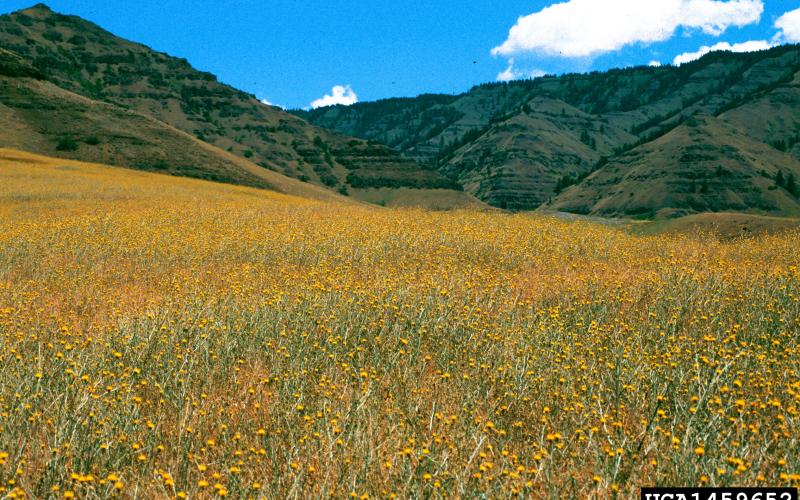Common Name: Yellow Starthistle
Scientific Name: Centaurea solstitialis L.
Related Species: Other knapweeds and starthistles including the similarly yellow-flowered starthistles C. melitensis L. and C. sulphurea Willd.
Legal Status
All above and below ground parts of the plant must be destroyed. Additionally, no transportation, propagation, or sale of this plant is allowed. Failure to comply may result in an enforcement action by the county or local municipality.
Background
Yellow starthistle is native to the Mediterranean region and was introduced to North America in contaminated seed. It is one of the most serious weed species in the West. There are no documented reports of yellow starthistle in Minnesota. If allowed to establish in Minnesota, it is probable that yellow starthistle would be highly damaging. The goal is to find and eliminate populations before they become established and spread.
Description
- An annual (occasionally biennial) weed, yellow starthistle forms a rosette in the fall. Basal rosette leaves are lobed and approximately 2- 3” long.
- Plants bolt in the spring and summer and send up multiple flowering stalks. The stems are winged and branched. Stem leaves are alternate, narrow, have few or no lobes, and are approximately ½- 1” long. The grayish-green stems and leaves are covered with wooly hair.
- Height is highly variable, ranging from 6 inches to 6 feet depending on conditions. Plants average 1- 3 feet in height.
- Flower heads are golden yellow and approximately 5/8” in diameter. A pointed yellowish spine is formed at the end of each bract. Together they look like a ring of spikes just below the flowers. The flowers are pollinated primarily by bees.
- Two types of seed are produced. Seeds in the center of the seedhead have white pappi (fluffy hairs) that aid seed movement by wind and animals. Seeds near the seedhead edge do not have pappi.
Habitat
Yellow starthistle thrives in sunny, open areas such as grasslands, fields of alfalfa and small grains, and roadsides. It can tolerate a wide range of soil moisture conditions.
Means of spread and distribution
Yellow starthistle reproduces exclusively by seed. Seeds can remain dormant in soil for 10 years. Established stands produce large amounts of seed that can be spread by wind, water, vehicles, humans, wildlife, and by moving soil, hay, or grain containing seed. There are no documented reports of yellow starthistle in Minnesota.
Impact
In the West, yellow starthistle is invasive and displaces desirable vegetation, forming dense monocultures. Decreases in soil moisture, forage, and plant species diversity have been documented. Infestations reduce pasture forage quality and the spines can injure the eyes, noses, and mouths of grazing animals. Yellow starthistle is toxic to horses and causes “chewing disease.” Yellow starthistle seeds can be a contaminant in harvested grain, reducing quality and value. In natural areas, yellow starthistle can substantially diminish native plant and animal diversity.
Prevention and management
- Be on the lookout for yellow starthistle. It may arrive from one of the western states as a contaminant of other plant materials or on vehicles or other equipment. Only certified seed should be used for pasture seeding. If you suspect that you found yellow starthistle, please report the find to the Minnesota Department of Agriculture.
- Yellow starthistle management tools and methods include hand pulling, herbicide application, biological control, targeted grazing, and prescribed burning. In Minnesota, eradication is the treatment goal so all plant parts must be destroyed either by hand pulling and bagging or by herbicide treatment. If using herbicide treatments, check with your local University of Minnesota extension agent, co-op, or certified landscape care expert for assistance and recommendations.
Toxicity
Yellow starthistle is toxic to horses and causes chewing disease. In most cases, horses die from starvation or dehydration because chewing disease results in permanent, untreatable brain damage to the fine motor control area. Yellow starthistle is not toxic to other grazing animals, including mules and burros.



